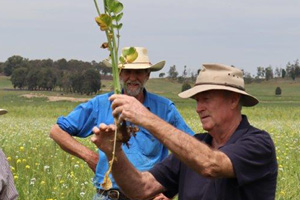Multispecies Forage Crops for Lamb Production, Carbon Sequestration and Offsetting Livestock Emissions
Case Study
2020 MLA Landcare Excellence in Sustainable
Farming Grant Project
| Grant Recipient: | Watershed Landcare Group |
| State/Town: | New South Wales Central Tablelands |
Project Background, Objectives and Implementation
Cold temperatures during the winter months in areas like New South Wales’ Central West, are the principal factor affecting pasture growth and can result in a winter-feed gap. To help alleviate this, the Watershed Landcare Group wanted to conduct a trial project building on growing evidence from Australia and the US that shows multispecies crops and pasture diversity can increase soil carbon, nutrient cycling and improve soil biology and farm ecosystems.
In early 2020, as part of their community focused Australian Good Meat initiative, Meat & Livestock Australia (MLA) in partnership with Landcare Australia funded the Watershed Landcare Group’s project with a MLA Landcare Excellence in Sustainable Farming Grant.
The project was conducted just north of Gulgong in New South Wales, on an 840-hectare property consisting of restored native pasture. Colin Seis, the landholder, was the 2016 winner of the prestigious Bob Hawke Landcare Award. On his property, called Winona, he runs 4,000 merino sheep for wool, merino lamb and mutton production. The pasture is restored native grassland consisting of 50 native grassland species. The Seis family has farmed at Winona since the 1860s.
Project Implementation
The project demonstration site was set up in a 12.5 ha paddock of native grassland, subdivided to provide two grazing trial plots; six ha multi-species and 6.5 ha single species (barley).
A multispecies mix forage crop was zero-tilled (pasture cropped) into a dormant native grassland in March 2020. The mix of six species in the multispecies crop (barley, field pea, faba bean, Winfred forage brassica, tillage radish and turnip) with its diverse mix of plant roots and flowering plants aims to build soil carbon and biology that cycles nutrients.
An adjacent area (paddock division) was sown to a single species (barley) fodder crop as a comparison. The project and control paddocks were used to fatten and finish merino lambs from May to July, with weight increases in the sheep periodically monitored over the course of the trial.
Data was collected to compare the multispecies pasture crop and the barley crop. Animal performance (weight gain) and pasture biomass were periodically monitored during the grazing trial. Changes in soil carbon, structure, chemistry and grassland species were monitored pre-sowing and post-grazing.
Professor Luciano Gonzalez and his team from the University of Sydney (Agriculture) provided valuable assistance with data analysis.
Project Outcomes
Initial results show promising improvement in groundcover and soil structure. Soil analysis results from multispecies and barley grazing plots show substantial (>20%) changes in some parameters between the start and end of the trial.
Animal performance results (weight gain) from the trial are encouraging as perceived reduction in livestock performance is often a hindrance to the uptake of sustainable agriculture practices.
The grant funding provided resources and capacity for the Watershed Landcare Group to support pioneering farmer, Colin Seis, in demonstrating an innovative farming practice whist collecting objective data to provide an evidence base for its future uptake.
Implemented by a trusted local landholder, the project provided important context for local graziers and land managers. Information imparted to landholders by trusted peers gives them confidence to try new ideas and adopt and maintain long-term sustainable land management practices.
Darren Baguley, local grazier and member of the Watershed Landcare Grazing Group said, “I have been to Col Seis’ property for several field days but the latest paddock walk, looking at the results of this multispecies crop trial was the best so far.
“Sustainable agriculture experts have inspired many of us to plant multispecies cover crops in a bid to increase soil carbon, crop biomass and perennial plant diversity. However, no one has thought to ask, ‘Are multi-species cover crops profitable?’ According to the trial on Col’s property, Winona, the answer is a resounding yes!”
Ongoing Work
To build on the evidence base of the benefits of multispecies pasture cropping, the grazing trial and monitoring activities will continue over the next few years. From 2021-2024, a diverse, multispecies forage crop and single species crop will be sown on the same areas; animal performance, soil and pasture parameters will be measured and recorded over this time. Of particular interest are changes in soil carbon, nutrient cycling, groundcover and pasture composition over a longer time frame.
Continuation of the grazing trial will build on work achieved during this project and allow us to continue to provide our members and the general community with information and training on innovative farm practices, pasture and land management as well as encouragement and evidence to adopt more sustainable land management practices.





